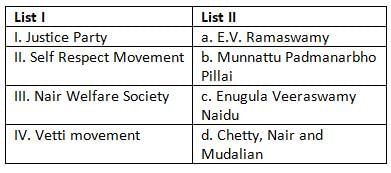MH SET Paper 2 Mock Test - 5 (History) - MAHA TET MCQ
30 Questions MCQ Test MH SET Mock Test Series 2025 - MH SET Paper 2 Mock Test - 5 (History)
Which Mughal emperor met Vaishnava saint Gosain Jadroop?
Din-i-ilahi Consists elements primarily from:
Who was the priest of the Bharatas in the battle of Ten Kings ?
Which one of the following native states was NOT annexed by the British on the basis of the Doctrine of Lapse?
Who was a prominent poet in the court of Samundragupta?
In Pali texts, who among the following is referred to as Nigantha Nataputta?
Consider the following statements about Buddhist councils in India?
1. First Buddhist Council conducted under the patronage of King Bimsara of Haryanka dynasty in Rajgriha.
2. Second Buddhist Council conducted under the patronage of King Kalasoka of Sisunaga dynasty in Pataliputra.
3. Third Buddhist Council conducted under the patronage of Emperor Ashoka of the Maurya dynasty in Vaishali.
Which of the above statements is/are not correct?
Who was the author of the Gwalior Prashasti of Mihira Bhoja?
Which of the following is true regarding Government of India Act 1935?
1. The Act never came in force; as princely states did accept the provision of the act.
2. The act abrogated the doctrine of Paramountcy of British over the Princely states in India.
Select the correct answer using the code given below: -
Regarding Wood’s Dispatch, which of the following statements are true? (UPSC CSE 2018)
1. A Grants-in-Aid system was introduced.
2. The establishment of universities was recommended.
3. English as a medium of instruction at all levels of education was recommended.
Select the correct answer using the code given below
Consider the following statement about Hellenistic art :
1. The Sakas introduced features of Hellenistic art in the North-West frontiers of India.
2. The Hellenistic influence appears in the Pillars of Ashoka.
3. Gandhara art is the best example of Hellenistic influence.
Which of the statements given above is/are correct?In which Buddhist Council, Buddhism was divided into Mahayana and Hinayana sects?
Which of the following pairs is/are correctly matched?
- Acharya Nagarjuna:- The Kant of India
- Dharmakirti:- The Einstein of India
Select the correct answer from the codes given below :
Consider the following events in the history of India:
1. Rise of Pratiharas under King Bhoja.
2. Establishment of Pallava power under Narshimhavarman I.
3. Establishment of Rashtrakutas power by Dantidurga.
4. Rise of Pala dynasty under Dharmapala.
What is the correct chronological order of the above events, starting from the earliest time?
Who was the first Muslim to invade India in 712 AD?
Consider the following pairs:

Which of the pairs given above is/are correctly matched?
In which year English was made the medium of instruction in India ?
During British Era, the Duke Memorandum became the basis of which among the following?
|
60 tests
|















